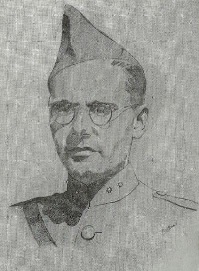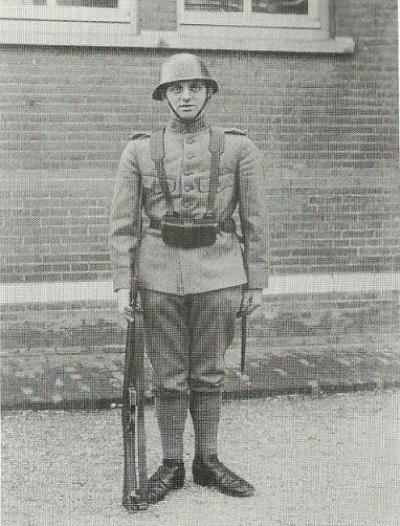On 10 May 1940, before dawn the mighty army of Nazi-Germany invaded Belgium and the Netherlands. Both small countries had been able to deploy their troops to strategic positions, but the Germans were sure it would only take little effort to overwhelm them. Although the Dutch defenders were equipped with materials of over 50 years old and underpowered rifles, they offered fierce resistance.
One of the most important defensive lines was the Juliana Canal, dug during the 1930s. At the western side of the canal there were troops, mostly draftees. Their main objective was to prevent the Germans from crossing the canal and reaching the river Meuse at any cost. All the bridges were rigged with dynamite.
In the early morning of 10 May 1940, Dutch lieutenant Henk Nijland (picture 1) saw soldiers approaching from the eastern side of the bridge. The soldiers were dressed in Dutch uniforms. There had been no briefing of troop movement through the sector, especially that early. Nijland entered the bridge, followed at a short distance by corporal Mindert Epema (picture 2). The approaching soldiers however, were not Dutch at all. They were Germans, dressed in fake Dutch uniforms, made from old curtains. On their heads they wore fake helmets of Papier-Mâché. Before lieutenant Nijland understood it was an ambush, he was shot. Corporal Epema tried to reach for his weapon, but was killed as well. Epema, being the company’s engineer, was responsible for blowing up the bridge, which now fell into German hands unscathed.


Lieutenant Henk Nijland (left) and Corporal Mindert Epema (right)
The Dutch west of the bridge threw everything they had at the Germans, to prevent them from reaching the river Meuse. Several German soldiers were killed during the fights. Eventually the enemy seemed too strong. The soldiers had to surrender when they were surrounded by Germans who had crossed the canal by several other bridges.
Another soldier who was present at the bridge on that specific morning, was Huub Baggen from nearby Geleen. The Dutch army normally used a policy of sending draftees to different parts of the country, to prevent them from going home unauthorised. Baggen however was quite a talented football player. His coach, doctor van Nieveen, who also happened to be the town’s physician, had convinced the army staff to keep Baggen close to home, so he could play football now and then with his club, FC Geleen-Zuid.
At the moment of the attack, Baggen was unarmed. When the shooting started, he found himself right in the line of fire. In order to save his life, Baggen jumped off the bridge, but instead of landing in the water, he hit the tow-path, injuring his back. Besides, he noticed that he had been hit in the leg twice. Fighting the pain, Huub Baggen started to walk south, towards Berg. Near Berg he came across a company of German soldiers. Now he was officially a prisoner-of-war, but because he was injured, he would first have to be treated. He was put in the sidecar of a Wehrmacht motorbike and taken to the nearest German field hospital. On the way, they ran into a traffic jam, caused by a German road block. It didn’t take long for Huub to be recognised by someone: Doctor van Nieveen. The doctor quickly examined the wounded soldier and told the officer on the bike that this man’s injuries were ‘very serious’ and that he definitely needed treatment in a real hospital. After Van Nieveen promised the German to take Baggen there himself, he was given permission to do so. Instead of taking him to Sittard however, the doctor took him straight back to Geleen, saving him from several years in a German POW-camp.
The monument for Lieutenant Nijland and Corporal Epema was revealed in 1992. Huub Baggen never missed a single memorial ceremony for his fallen comrades. He passed away in January 2011, at the age of 96.
This cache is part of a series. The caches are:
'40-'45: Kapelaan Berix (GC2PEZJ) (in English) '40-'45: Veer Berg-Meeswijk (GC2PEXA) (in English) '40-'45: Brug Obbicht (GC2PER6) '40-'45: Sluis Born (GC2PEP0) (in English) ’40-’45: Brug Roosteren (GC2TV5X) (in English) '40-'45: Sittard War Cemetery (GC2TV9R) (in English) '40-'45: Staff Sergeant Booher (GC2TQC1) (in English) '40-'45: Jürgen G. Krohnke (GC2X5V3) (in English) '40-'45: RCAF Bomber Crew (GC2X60A) (in English) '40-'45: Schepenkerkhof (GC2X6KF) (in English) All caches contain a bonus number. When you find all 10 of them, you can search for the bonus cache (GC2X6MV).All caches contain a bonus number. When you find all 10 of them, you can look for the bonus cache (GC2X6MV).
Did you find one or more caches in the series before there were bonus numbers added? Send me a message,telling which caches you’ve found and on which date. I will try to send you the bonus numbers as soon as possible!
Hint:
Magnetic. Look at the side which gives many people a warm feeling!
Geen opmerkingen:
Een reactie posten